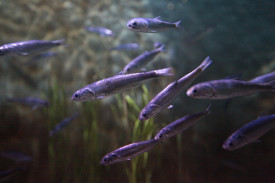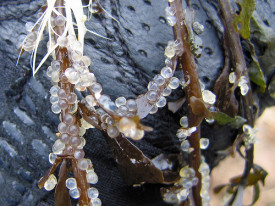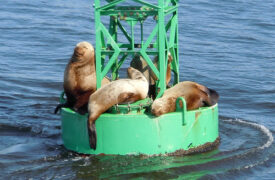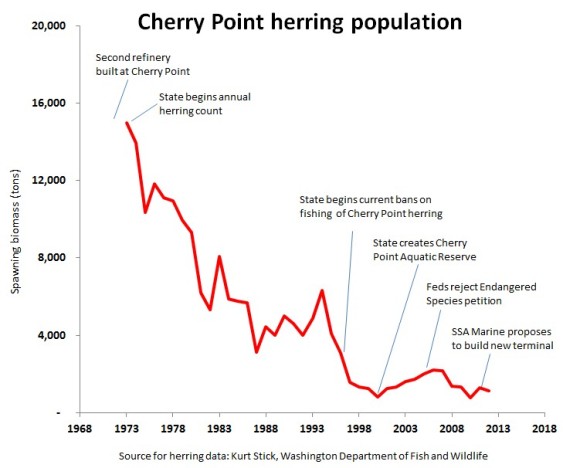Editor’s note: A revised version of this article is available as a pdf.

Puget Sound’s Pacific herring are a small fish with a whale-sized slate of problems.
Many of the local herring stocks are in decline and despite some localized efforts to save them, their numbers haven’t bounced back. Scientists have identified numerous culprits that have likely contributed to the waning populations, including disease, pollution, increasing numbers of predators, climate change, shoreline development, and fishing.
But from this line up of offenders, no one has been able to pinpoint the villain that bears the greatest blame for the herring’s troubles.
It hasn’t been for a lack of trying.
The Washington Department of Fish and Wildlife keep the closest watch over Puget Sound’s approximately 20 Pacific herring stocks, with particular attention to the fish that spawn at Cherry Point north of Bellingham. The Cherry Point herring were once the largest stock in Puget Sound, but the population has been in a near freefall for decades. The number of spawning fish plummeted 92 percent from 1973 to 2012, according to data from the WDFW’s Kurt Stick.
Not all of the herring are in such dire straits. In its 2008 assessment, the most recent available, WDFW concluded that 47 percent of the region’s herring stocks were “healthy” or “moderately healthy,” based on their abundance.
However, that only tells part of the story. Wayne Landis, director of the Institute of Environmental Toxicology at Western Washington University and herring population expert, drilled into WDFW data that included information about the age of the fish. Age matters because older fish have more and healthier offspring.
In a paper published in 2010, Landis concluded that in the ‘70s, local herring sometimes lived 8 or 9 years, but that over time the stocks have been getting younger until now most live only to age 2 or 3. And this trend toward younger fish was seen in populations not just at Cherry Point, but around Puget Sound.
But because Cherry Point was such an important stock historically and one that dropped so far, the fish there have garnered special attention.

While the state still allows some herring fishing in Puget Sound, Cherry Point fish and eggs were put off limits for a period in the 1980s, and then permanently in 1996. In 2000, the state Department of Natural Resources created the Cherry Point Aquatic Reserve to “protect the significant environmental resource” of the area –– including the herring. Four years later, conservationists tried unsuccessfully to get Endangered Species Act protections for the beleaguered population. (The petition was denied in large part because federal scientists argued that other herring stocks could repopulate the Cherry Point area should the fish there vanish, though other researchers are skeptical.)
A Sea of Hurt
A closer look at the herring shows that they suffer from a variety of physical afflictions.
Puget Sound herring are infected with viral diseases and a parasite called Ichthyophonus hoferi, which creates heart and liver lesions, possibly impeding their swimming. Research on the parasite in 2002 by University of Washington, WDFW, and U.S. Geological Survey scientists found that in some stocks, more than half the fish carried the parasite and older fish had higher infection rates.

A 2005 study by many of the same researchers took a closer look specifically at the Cherry Point fish. They found the stock suffered from an unusually high frequency of skeletal abnormalities and the fish were smaller and weighed less.
Many folks concerned about the herring suspected that pollution could be the trigger for the ailments and stock decline. The region is home to industrial activities including an aluminum smelter and petroleum refineries that are now operated by ConocoPhillips (also called Phillips 66) and BP. Plus, Puget Sound is continually hit with a deluge of pollution that’s carried into the sea with stormwater runoff.
Research on the mutating and deadly effects of petroleum toxics on herring eggs is well documented from the Exxon Valdez spill to a more recent accident in San Francisco Bay. Fred Felleman, a tireless advocate for the herring who holds a UW master’s degree in fisheries biology, points to a rarely discussed 1972 oil spill in the Cherry Point area as another potentially significant blow to the fish.
So the researchers investigating the mutant Cherry Point herring incubated their eggs in water from elsewhere in the Sound, and took eggs from other stocks and raised them in Cherry Point water. They found that the Cherry Point fish were abnormal regardless of where the water came from.
Around the same time, other scientists delved into the amount of pollution in the adult herring, still searching for answers to the herrings’ woes.
Jim West at WDFW and Sandy O’Neill and Gina Ylitalo at the Northwest Fisheries Science Center have taken a pollution pulse for countless species swimming in the Sound. They tested for persistent organic pollutants in herring caught in three spots in Puget Sound and those from three areas in the Strait of Georgia, including Cherry Point. The chemicals accumulate in organisms and can be passed from mothers to offspring.
The Puget Sound herring were deemed to be “significantly contaminated with PCBs, and to a lesser degree DDTs…” according to the research published in 2008; the Cherry Point fish were polluted too, but at lower levels.
No one had yet found the smoking gun to explain what some were now calling the Cherry Point Pacific Herring Syndrome.
Home, Inhospitable Home

But of course it’s not enough to look only at the physical condition of the fish. Scientists also have tried to unravel what’s happening with herring predators and habitat.
The tally of what doesn’t eat Pacific herring is possibly shorter than the list of what does. Marine ducks, seabirds, and crabs eat their eggs. Jellyfish and other squishy creatures slurp the larval herring. Chinook salmon, sea lions, seals, and still more birds gobble the adult fish.
Climate change and the Pacific Decadal Oscillation, or PDO, can warm water temperatures and potentially increase the herrings’ predators, scientists predict. Much of the Cherry Point stock’s plummet coincided with a so-called warm phase in the PDO. However, the fish haven’t rebounded during recent colder cycles.
Herring have specific environmental needs, namely shoreline areas that provide eelgrass where they deposit their sticky, tapioca-pearl eggs. The newly hatched fish also linger near these beaches after hatching. Researchers are concerned about the effects of shoreline development and activity, which can disrupt natural processes that replenish sandy beaches; destroy eelgrass beds; alter predator-prey interactions; and generally disturb fish behavior.
Human encroachment already has put the squeeze on herring. Based on spawning surveys, scientists know that in 1981, Cherry Point herring spawned along more than 60 kilometers of shoreline. By 2004, the fish utilized less than 22 km of the nearshore.
The shift is worrisome, whether it’s the result of the fish population getting smaller or because of human activity in the area. A 2006 report from the National Marine Fisheries Service concluded that the shrinking spawning area “increases risks” from man-made insults such as “oil spills and contaminant releases near Cherry Point.”
Cherry Point’s Future
The tidal wave of troubles confronting Puget Sound herring region-wide, and the Cherry Point stock in particular, are facing closer scrutiny once again. That’s because Pacific International Terminals, a subsidiary of SSA Marine, is proposing to build a deep-water shipping hub in Cherry Point to transfer coal from trains to large vessels.

Project proponents say that their planned wharf and trestle would include numerous features to protect the environment, such as metal grating for the decking to limit the amount of shading that can kill eelgrass; a design that will prevent disturbance of the bluff and shoreline; and covered conveyors to prevent coal dust from blowing into the water.
Additionally, government agencies are working on an Environmental Impact Statement to assess what effect the proposed Gateway Pacific Terminal could have on human health and the marine ecosystem. The project could be modified to better protect the environment if that is deemed necessary. And terminal supporters say they currently plan to conduct field research on the Cherry Point herring in partnership with state agencies. This research is a requirement of a 1999 settlement agreement between Pacific International Terminals, state agencies, and the non-profit Washington Environmental Council.

Some local herring experts remain concerned about risks associated with more shoreline development, increased train and ship traffic, the potential for oil spills, and the threat of invasive species tagging along with the shipping vessels. They ask whether Pacific International Terminals’ project can really be protective enough for the herring.
“They have to guarantee that they do not alter the spawning habitat,” said WWU’s Landis. “Have they done that? I’m not sure how you do that.”
Editor’s note: If you want to hear more from the researchers themselves, I wrote a news story about the mysterious disappearance of the herring for Crosscut.



Comments are closed.